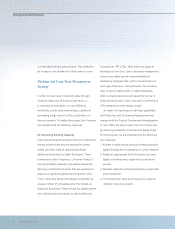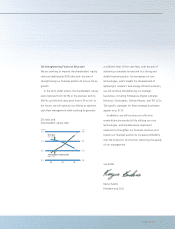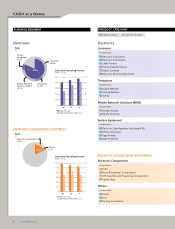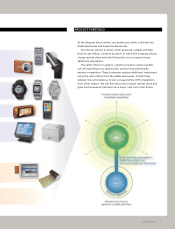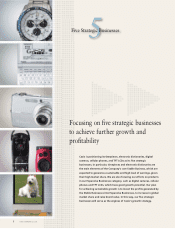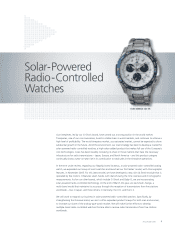Casio 2006 Annual Report Download - page 16
Download and view the complete annual report
Please find page 16 of the 2006 Casio annual report below. You can navigate through the pages in the report by either clicking on the pages listed below, or by using the keyword search tool below to find specific information within the annual report.
Research and Development
Casio’s Research and Development Policy
In line with the meaning behind our corporate creed “Creation and Contribution,” Casio aims to contribute to society
through the development of original products. Leveraging our core competence in lightweight, compact
and energy-effi cient technologies, such as high-density mounting, LSI design, software / IP compatibility,
telecommunications and digital broadcasting systems, and electronic component technologies, we have been able to
develop a diverse line-up of customer-oriented products.
Casio’s R&D structure comprises two systems: 1) Basic research and elemental technology development, which
focuses on new businesses and incorporates a medium-to-long-term perspective, and 2) development aimed at
product commercialization, which relates directly to our existing businesses.
In addition, through alliances with central and local governments and academic institutions, including national and
prefectural research institutes and universities, we are actively pursuing collaborative projects in fi elds that promise
growth over the medium-to-long term, as well as technological fi elds that show possibilities for innovations in our
core technologies.
Achievements in R&D:
Fuel Cell Development
Casio is in the process of developing an ultra-compact fuel cell battery for use in notebook PCs and other mobile
information equipment. In March 2002, the Company succeeded in miniaturizing its fuel reformer module, which had
been considered diffi cult to achieve. Since then, our R&D efforts have focused on improving this fuel cell battery for
use in mobile appliances.
We have already developed practical module products incorporating our reformer system, which extracts hydrogen
from methanol and then sends the hydrogen to the power-generation cell. Regarding power-generating devices, we
have developed a new, compact power-generating cell stack with the highest level of power density per unit volume
in the world. When used in combination with the reformer module and the compact power-generating cell stack,
which is the size of an ordinary rechargeable lithium ion battery, it has a lifetime about four times as long. We will
continue working to achieve technological advances, and aim to begin sample shipments for performance evaluations
by the end of March 2008.
Power-generating cell stack
Micro reformer module
14 CASIO COMPUTER CO., LTD.


